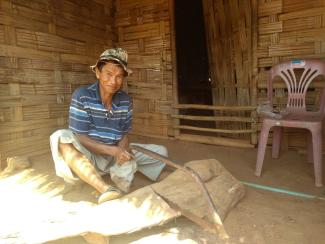ASEAN
“Refugees can make contributions to host communities”

What is the situation for refugees or displaced persons in the Asia-Pacific region?
Overall there is a lack of protection for refugees across the region: only 20 out of 45 countries have signed on to the 1951 United Nations Convention Relating to the Status of Refugees. Among the ten member states of the Association of Southeast Asian Nations (ASEAN), only two, the Philippines and Cambodia, are signatories. Even countries that are signatories often do not adhere to the principles enshrined in the Convention. For example, Cambodia has a track record of returning refugees to countries from which they have fled. Australia continues to violate its international obligations by practicing offshore processing, indefinite detention and intercepting boats at sea. Compounding this issue, many countries do not have national laws or frameworks in place to protect refugees. Some have reservations to other international human-rights laws, treaties and conventions. The overall lack of legal status in the region leads to refugees and stateless persons being managed under immigration laws and treated as “illegal immigrants”. This causes a situation where particularly urban refugees are in constant fear of and subject to arbitrary and indefinite immigration detention, harassment and deportation. They also lack legal work rights.
There seems to be increasing use of detention of immigrants and refugees in the Asia-Pacific region. Why?
Globally we are seeing a narrative where refugees, asylum seekers and displaced persons are criminalised and discussed in the context of national security, rather than one of human rights and protection. Some governments – like Australia – employ detention as a means of deterrence. However, all studies and data show that this practice does not work. Furthermore, it fails entirely in addressing the root causes of displacement, such as conflict, persecution and discrimination. An example of this is Myanmar where denial of citizenship as well as racial and religious discrimination have led to the displacement of large numbers of Rohingya (see Ridwanul Hoque and Ashraful Azad in D+C/E+Z e-Paper 2019/04, focus section) and ethnic minority groups such as the Karen, Karenni, Shan and others.
What are the effects of immigrant detention?
It has severe impacts on the physical and mental wellbeing of people. The impacts are well documented: mental illness, increase in suicide attempts and poor physical health and deaths in detention. A report details how the conditions and cuts in health-care provision in Australia’s offshore immigration-detention system led to suicide, suicide attempts and self-harm among the refugees. In the case of children, detention and separation of families often lead to developmental impairment, self-harm, suicidal thoughts and suicide. Children are at risk of violence, suffering sexual and physical abuse and trauma. Immigration detention violates human rights, but it does not deter any refugees from leaving their countries.
What can the APRRN do about this?
We try to make governments understand that refugees are not burdens, but through for instance local integration and legal work rights they can make contributions to host communities. For example in Thailand, APRRN together with a coalition of Thai human-rights and child-rights NGOs has engaged in advocacy efforts towards government stakeholders and decision-makers. The collaborative efforts have led to the signing of a Memorandum of Understanding on ending child detention. Furthermore, APRRN and its partners are working with the government on developing and implementing an “Alternatives to Detention” (ATD) pilot project.
What are Alternatives to Detention (ATD)?
ATDs for children and their parents or caregivers can take many different forms including community housing (underpinned by the development of a robust case management system), foster-care of Unaccompanied Asylum Seeking Children (UASCs), provision of temporary or permanent residence visas, and legal status which affords refugees with protection or immunity from arrest and detention. It is a cheaper, more effective and more humane way to manage migration. ATDs are up to 80 % cheaper than detention. They also provide added benefits like supporting the health and wellbeing of migrants, reducing overcrowding in detention centres and helping governments to fulfil their human-rights obligations.
Does the legal framework of the ASEAN states offer enough protection for refugees?
ASEAN does not have a legal framework for the protection or promotion of refugee rights. Several individual states within ASEAN furthermore hold reservations to other international human-rights laws and standards. Whilst there is an ASEAN Declaration on Human Rights (ADHR), it does not specifically cover refugee protection. Other factors that influence the scope for engagement include a lack of funding and resources for refugee protection.
What could ASEAN as an intergovernmental organisation do in order to improve the situation for refugees within its states?
ASEAN needs to move beyond its principles of non-interference and national sovereignty and acknowledge that displacement and forced migration are regional issues with potentially destabilising effects, which require regional cooperation. The 2007 ASEAN Declaration on the Protection and Promotion of the Rights of Migrant Workers focuses solely on migrant workers and does not mention refugees or asylum seekers. ASEAN should develop a regional framework and a common set of refugee and asylum policies, which includes guidance for action to be taken when a member state’s internal issues causes people to flee to neighbouring states. Such an instrument could help to ease both the escalation of conflicts and any future ethnic or religious tensions between states.
What do you regard as the most urgent challenges across the Asia-Pacific region regarding migration?
In addition to immigration detention, I would highlight three refugee populations, which all underscore the urgency for addressing the lack of durable solutions for refugees:
- The first is found in Thailand along the border with Myanmar, where 100,000 Karen, Karenni and smaller numbers of other Myanmar ethnic minority groups have resided in nine Temporary Shelters for Displaced Persons for 30 years.
- Yet another ethnic minority group, the Chin, fled Myanmar to India and Malaysia. The Chin are facing an uncertain future as the UNHCR has started the process of cessation of their refugee status, having deemed that they are no longer in need of international protection.
- Finally, in August 2017 the world witnessed the mass exodus of more than 700,000 Rohingya from Myanmar to Bangladesh. This was propelled by outbreaks of violence in Myanmar’s Rakhine State. The Rohingya are a population group who the Myanmar government does not recognise as citizens, effectively making them stateless. They now reside in a staggering number of more than 900,000 in Cox’s Bazar, Bangladesh, making it one of the most densely populated and now largest refugee camps in the world.
These refugee populations have one condition in common: the underlying causes of their displacement have yet to be addressed in a comprehensive manner.
How can APRRN influence the general trend?
Through joint advocacy and lobbying, APRRN aims to advance refugee rights at national, regional and international levels. At the national level we seek to strengthen local civil-society actors and national networks, with the goal of increasing and creating space for advocacy with regional bodies and mechanisms such as ASEAN.
Do you see any positive developments?
In Thailand APRRN and its partners are working with the government on developing and implementing an Alternative to Detention pilot project, and the government has publicly committed to developing a National Screening Mechanism, a national framework for managing refugees and asylum-seekers. In Malaysia, APRRN member SUKA Society take part in a working group which includes government stakeholders on finding alternatives, such as community placement for Unaccompanied Asylum Seeking Children (UASCs). In South Korea, a comprehensive refugee bill was adopted in 2013, and in Taiwan APRRN’s work with legislators, judges and the National Immigration Agency has led to a draft refugee bill that largely mirrors the refugee convention, and if adopted, it would legally recognise refugees.
Sussi Prapakranant is a programme officer at the Asia Pacific Refugee Rights Network (APRRN). She lives in Bangkok, Thailand.
sussi@aprrn.info
http://aprrn.info/
LINK
Amnesty International and Refugee Council of Australia report, 2018:
https://www.amnesty.org/en/documents/asa34/9422/2018/en/








